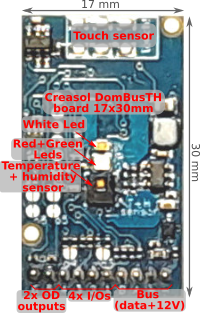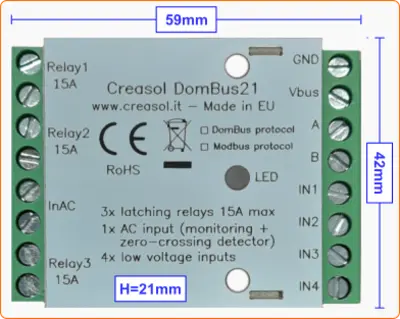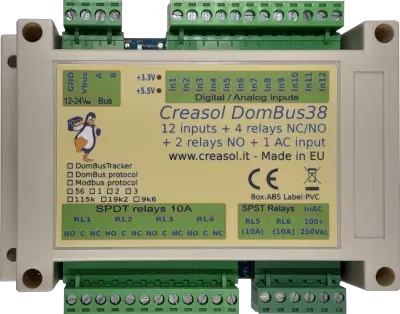

Email: store@creasol.it - Telegram: CreasolTech - Whatsapp: +393283730010
Priority mail: snel en goedkoop - Express Courie
Neem contact met ons op voordat u producten retourneert!

Slimme EVSE-module om zelf een EV-laadstation (wallbox) te maken dat ook werkt met het domoticz-domoticasysteem
 Volledige ondersteuning: de meeste producten zijn door ons ontworpen!
Volledige ondersteuning: de meeste producten zijn door ons ontworpen!
Email: store@creasol.it - Telegram: CreasolTech - Whatsapp: +393283730010
 Bestellingen worden binnen 1 werkdag verzonden
Bestellingen worden binnen 1 werkdag verzonden
Priority mail: snel en goedkoop - Express Courie
 24 maanden garantie, eenvoudig retourneren/restitueren
24 maanden garantie, eenvoudig retourneren/restitueren
Neem contact met ons op voordat u producten retourneert!

Creasol DomBusEVSEis een volledig geteste DIN-rail module, ontworpen voor Domoticz domotica systeemelektrische voertuigen opladen met de standaardIEC 62196-2Modus3(AC-lading, tot 22kW vermogen).
Het werkt alsop zichzelf staand(zonder enige domotica controller) of inbeheerde modus(laadstroom geregeld door Domoticz).
In stand-alone modus werkt hij alleen als enkelfasige lader, omdat het alleen DDS238-2 ZN/S energiemeter (enkelfasig) kan lezen;met domoticz domotica kan driefasig opladen worden beheerddoor de huidige waarde van het netvermogen van Domoticz op te halen (bijv. SDM630 of andere vermogensmeter die al in Domoticz is geïnstalleerd). De vermogenswaarde van het elektriciteitsnet is nodig voor DomBusEVSE om de laadstroom te regelen om overbelasting/onderbrekingen te voorkomen, en ook om het door de gebruiker ingestelde maximale vermogen te behouden: meer info hieronder.



Hoewel dit een volledig getest product is, mag het alleen door technische ingenieurs worden gebruikt voor ontwikkeling of demonstratie. Creasol wijst alle verantwoordelijkheid af voor schade aan zaken of personen.
De netvoeding (230V enkelfasig, 400V driefasig) is aangesloten op het voertuig via een 2P- of 4P-schakelaar (relais) om te verzekeren dat er geen stroom wordt toegevoerd wanneer de laadsessie UIT is.
Alleen de stuurautomaatdraad + aarde/massa zijn aangesloten op de EVSE-module: de stuurautomaat wordt beschermd door een apparaat voor overspanningsonderdrukking.
Een slimme EVSE-module:
Met Domoticz is het ook mogelijk om de voertuigcloud te verbinden om andere informatie te krijgen over de laadtoestand van de batterij, kilometerteller, locatie, snelheid, ...
Het volgende diagram toont de aansluiting van de EVSE-module op de energiemeter, contactor, aardlekschakelaar om een complete slimme wallbox te krijgen, enkelfasig 230V, die de netstroom detecteert om de beste laadsnelheid te krijgen en overbelasting en ontkoppelingen te voorkomen.Blokschema is ook beschikbaar in PDF-formaat.
Het is mogelijk om een driefasige lader te maken door de schakelaar te vervangen door een 4P-versie en een driefasige energiemeter te gebruiken die is aangesloten op Domoticz, zodat de stroom die van het elektriciteitsnet wordt afgevoerd door Domoticz wordt teruggevoerd naar de DomBusEVSE-module.
Dit apparaat is alleen ontworpen voor technische ingenieurs, voor ontwikkelingsdoeleinden. Creasolwijst elke verantwoordelijkheid af voor schade aan zaken of personen.
Maak alle bedrading zoals aangegeven in het bovenstaande schema (klik om het PDF-schema met hogere resolutie te krijgen), maar sluit alleen de energiemeter die energie meet aan op het elektrische voertuig.
We raden aan om de wallbox-modules in een schakelkast binnenshuis te plaatsen, mogelijk in de buurt van het punt waar u uw auto parkeert, maar ook in de buurt van de hoofdschakelkast of de omvormer voor zonne-energie, indien aanwezig, om de kabellengte te minimaliseren: gebruik 6 mm² (of 10 mm²) draden voor de netvoeding. Plaats vervolgens een klein kastje van 10x10cm waar de elektrische auto geparkeerd staat, binnen of buiten, verbonden door 3x 6mm² (of 10mm²) draden (L,N,PE) plus een afgeschermde 2x0.22 mm² kabel (standaardkabel voor alarmsystemen): één draad is aangesloten op het CP-klemmenblok (besturingspiloot) en andere draad + afscherming zijn aangesloten op PE/GND. Op het kastje wordt de Type-2 of Type-1 kabel (met alleen stekkerverbinding naar het voertuig) aangesloten.
In het geval dat het apparaat stand-alone wordt gebruikt, zonder aangesloten domoticacontroller, moeten energiemeters al zijn geconfigureerd met Modbus-adres=2 (naar EV) en adres=3 (naar net): ze kunnen worden gekocht bij Creasol Store en vragen om adres al geprogrammeerd. Het is ook mogelijk om te vragen dat de EVSE-module is voorgeprogrammeerd met de juiste waarde van MAXPOWER (max. vermogen van het net), MAXCURRENT (max. stroom ondersteund door de EV-kabel).
De volgende instructies hebben betrekking op de Domoticz- controller, een gratis open-source domotica-controller die een volledige controle over de wallbox mogelijk maakt en die ten zeerste wordt aanbevolen : het werkt in goedkope hardware zoals Rock PI-S of Raspberry PI4 , net als Linux-computers, Windows en Mac.
Het is aan te raden om Domoticz Beta te installeren, wat up-to-date is, Python Plugin Manager (niet beschikbaar in Windows), daarna is het mogelijk om de Creasol DomBus plugin te installeren vanuit Python Plugin Manager: op deze manier is het mogelijk om notificaties te krijgen over toekomstige updates van de DomBusplug-in en automatische upgrade.
DomBusEVSE kan via een USB/RS485-adapter op de domoticacontroller / pc worden aangesloten: een apparaat wordt automatisch toegevoegd aan Domoticz -> Schakelpaneel, met fabrieksinstelling adres ffe3.1: klik op de knop Bewerken en voeg toe aan de Beschrijving , HWADDR =0x0001 of een ander uniek adres, klik vervolgens op de knop Opslaan: klik op Dashboard en vervolgens weer op Switches om onderaan de EVSE-apparaten te zien: EVSE On, RL2, EVSE Supply, EVSE Mode, EVSE State, EVSE Current. Klik op EVSE-modus, bewerk de parameters MAXPOWER en MAXCURRENT en sla op.
Maak een nieuwe kamer om alle EVSE-apparaten te groeperen: Instellingen -> Meer opties -> Plannen -> Ruimteplan, voeg een nieuwe Wallbox of iets anders toe en voeg alle apparaten toe met een adres dat overeenkomt met de eerder ingestelde HWADDR. Klik vervolgens op Dashboard en selecteer de Wallbox- ruimte.
Aangezien energiemeters in de fabriek zijn geprogrammeerd met Modbus-adres 1, sluit u eerst de energiemeter aan tussen aardlekschakelaar type B en contactor en wijst u adres = 2 op deze manier toe: selecteer Domoticz -> Utility -> M1 Addr-apparaat, klik op de knop Bewerken en schrijf in het veld Beschrijving ,ADDR=2 en sla vervolgens op. Sluit vervolgens de hoofdenergiemeter aan (die het met het net uitgewisselde vermogen meet) en wijs adres=2 toe: selecteer Domoticz -> Utility -> M1 Addr-apparaat, klik op de knop Bewerken en schrijf in het veld Beschrijving ,ADDR=3 en sla het op.
Indien een energiemeter aangesloten op de elektriciteitsgrid al beschikbaar is, is het voldoende om een eenvoudig script te installeren dat, wanneer de stroom van het net verandert, de waarde van het "virtuele apparaat" bijwerktNetstroomdat wordt automatisch aangemaakt
Ten slotte heeft DomBusEVSE extra ondersteuning voor:
* SPST-relaisuitgang RL2, met 250V 5A-mogelijkheid, die voor elk doel kan worden gebruikt
* tot 4 energiemeters, dus 2 extra energiemeters (met adres=4 en 5) kunnen worden aangesloten om vermogensstatistieken te krijgen voor de warmtepomp, keuken, ....
Alle onderdelen moeten aanwezig zijn in deCreasol-winkel, maar niet de Type-2 of Type-1 kabel.
De volgende afbeelding toont de integratie in Domoticz van de EV (Kia Niro-auto, met behulp van de plug-in die beschikbaar is met Python Plugin Manager) en de DomBusEVSE-module; het laat zieneen reisnaar het Gardameer, Noord-Italië, met eenkorte laadsessie bij een 11kW station, endaarna een lange oplaadsessie met de DomBusEVSE wallbox in SOLAR-modus(enkel energie uit fotovolticum).
Tijdens de oplaadsessie thuis, in de SOLAR-modus, waren zowel de wasmachine als de oven ingeschakeld: in dit geval reduceerde de EVSE-module de laadstroom tot het minimum en beëindigde na 90 seconden de sessie totdat het beschikbare vermogen weer boven de STARTPOWER-parameter kwam . Zoals weergegeven in de onderstaande grafieken, zorgt de module ervoor dat er geen stroom van het net komt, in de SOLAR-modus.

Wanneer de DomBusEVSE-module is geconfigureerd inbeheerde modus, Domoticzis verantwoordelijk voor het instellen van de laadstroom zoals gewenst. Vanzelfsprekend worden alle beveiligingen met betrekking tot maximale stroom, minimale stroom en eventuele alarmen van de auto correct beheerd door de EVSE-module.
In de beheerde modus is het eenvoudig om:
1. stel eenvoudig deminimum en maximum batterijniveau
2. stel eenvoudig demaximale laadstroom
3.wanneer het batterijniveau onder het minimum is, laadt u op met het maximale vermogentoegestaan door de elektriciteitsmeter (in Italië afwisselend 90 minuten op maximaal vermogen + 27% en 90 minuten op maximaal vermogen + 10%,sneller opladen kan niet!Het elektrische systeem moet zorgvuldig worden gecontroleerd bij gebruik van maximaal vermogen, om oververhitting en brand te voorkomen!!)
4.wanneer het batterijniveau zich tussen het minimum en het maximum bevindt, laad dan alleen op met energie uit hernieuwbare energie uit fotovoltaïsche energie
Ook kan het maximale netvermogen worden aangepast om het maximale uit het net te halen.De onderstaande grafiek toont het geval van Italië, waar het maximaal beschikbare vermogen P+10% voor altijd is, en P+27% voor maximaal 90 minuten elke 180 minuten: laadvermogen zal zo hoog mogelijk zijn,het regelen van het laadvermogen om het maximaal beschikbare vermogen te krijgen om ontkoppelingen te voorkomen. Het laadvermogen wordt elke 6 seconden bijgewerkt om voor andere gebouwen te zorgenapparaten.

{youtube}fyDtGO6S1UI{/youtube}
In het geval dat een stationaire accu in het gebouw is geïnstalleerd, zijn er twee gevallen mogelijk:
1. de DomBusEVSE-netenergiemeter wordt vóór de stationaire accu/omvormersensor geïnstalleerd (netvoeding -> DomBusEVSE-energiemeter -> batterijsensor)
2. de DomBusEVSE-netenergiemeter wordt geïnstalleerd na de stationaire accu/omvormersensor (netvoeding -> batterijsensor -> DomBusEVSE-energiemeter)
Om deze twee gevallen uit te leggen, gaan we ervan uit dat fotovoltaïsche energie 3kW produceert, het huis 1kW verbruikt, het maximale vermogen van de batterij 5kW is en het maximale vermogen van het net 6kW
| EVSE-modus | UIT | ZONNE | 25% | 50% | 75% | 100% |
| Case #1 oplaadvermogen (EVSE-meter, den batterijmeter) |
0 | 3-1=2kW | 3-1+1,5=3,5kW | 3-1+3=5kW | 3-1+4,5=6,5kW | 3-1+6=8kW |
| Geval #2 laadvermogen (batterijmeter, dan EVSE-meter) |
0 | 3-1+5=7kW | 3-1+5+1,5=8,5kW | 3-1+5+3=10 kW | 3-1+5+4,5=11,5kW | 3-1+5+6=13 kW |
Het is duidelijk dat een parameter de maximale stroom instelt die door de kabel wordt ondersteund, dat is meestal 32A, dus het laadvermogen is beperkt tot 7-8kW in een enkele fase.
The following video shows a presentation of some domotic modules designed and produced in Italy by Creasol to make a reliable, easy and power-optimized home automation system.
The next video shows our Smart EVSE module that can be used to charge the electric car by using only solar power, or adding 25/50/75/100% of available power from the electrical grid.
Our industrial and home automation modules are designed to be
Modules are available in two version:

Store website - Information website
For our products we can offer FULL SUPPORT and CUSTOMIZATION: please contact us by Email or Telegram
 Complete solution to make a Smart EVSE, charging the electric vehicle using only energy from renewable source (photovoltaic, wind, ...), or adding 25-50-75-100% of available power from the grid.
Complete solution to make a Smart EVSE, charging the electric vehicle using only energy from renewable source (photovoltaic, wind, ...), or adding 25-50-75-100% of available power from the grid.
 Compact board, 32x17mm, to be installed on blank cover with a 4mm hole in the middle, to exchange air for the relative humidity sensor. It can be installed in every room to monitor temperature and humidity, check alarm sensors, control blind motor UP/DOWN, send notifications (using red and green leds) and activate white led in case of power outage.
Compact board, 32x17mm, to be installed on blank cover with a 4mm hole in the middle, to exchange air for the relative humidity sensor. It can be installed in every room to monitor temperature and humidity, check alarm sensors, control blind motor UP/DOWN, send notifications (using red and green leds) and activate white led in case of power outage.
Includes:
 Very compact, versatile and cost-effective module with 9 ports. Each port can be configured by software as:
Very compact, versatile and cost-effective module with 9 ports. Each port can be configured by software as:
 Very low power consumption module designed to enable up to 3 high power loads, up to 15A (3kW).
Very low power consumption module designed to enable up to 3 high power loads, up to 15A (3kW).
 Versatile module designed to control gate or garage door.
Versatile module designed to control gate or garage door.
 DIN rail low profile module, with 8 relays and very low power consumption:
DIN rail low profile module, with 8 relays and very low power consumption:
 Versatile module with 230V inputs and outputs, and 5 low voltage I/Os.
Versatile module with 230V inputs and outputs, and 5 low voltage I/Os.
 Module designed to control 3 lights already existing and actually controlled by 230V pushbuttons and step-by-step relays. In this way each light can be activated by existing pushbuttons, and by the domotic controller.
Module designed to control 3 lights already existing and actually controlled by 230V pushbuttons and step-by-step relays. In this way each light can be activated by existing pushbuttons, and by the domotic controller.
Each relay can toggle the existing step-relay, switching the light On/Off. The optoisolator monitors the light status. The 5 I/Os can be connected to pushbuttons to activate or deactivate one or all lights.
 DIN rail module, low profile, with 12 relays outputs and very low power consumption.
DIN rail module, low profile, with 12 relays outputs and very low power consumption.
 Module designed to be connected to alarm sensors (magnetc contact sensors, PIRs, tampers): it's able to monitor mains power supply (power outage / blackout) and also have 3 relays outputs.
Module designed to be connected to alarm sensors (magnetc contact sensors, PIRs, tampers): it's able to monitor mains power supply (power outage / blackout) and also have 3 relays outputs.
 DIN rail module designed for burglar alarm system.
DIN rail module designed for burglar alarm system.
![]() DIN rail module that control azimuth + elevation/tilt motors of a sun tracker, to maximize photovoltaic energy production during the day and seasons.
DIN rail module that control azimuth + elevation/tilt motors of a sun tracker, to maximize photovoltaic energy production during the day and seasons.
 Simple module with 2 relays, to be used with DomBus modules or other electronic boards with open-collector or open-drain outputs
Simple module with 2 relays, to be used with DomBus modules or other electronic boards with open-collector or open-drain outputs
 IoT board designed for NodeMCU v3 board using ESP8266 WiFi microcontroller
IoT board designed for NodeMCU v3 board using ESP8266 WiFi microcontroller
The perfect match
Module works perfect with modbus connection to Loxone domotics via esphome RS485 interface.
Commands are send by Loxone with HTTP rest api to Lilygo RS485.
Cheap solution for DIY car charger. Thumbs up.
J'utilise HomeAssistant.
Très bien!
Utilizo este módulo con Home Assistant para recargar mi ID.4.
Funciona bien, muy inteligente